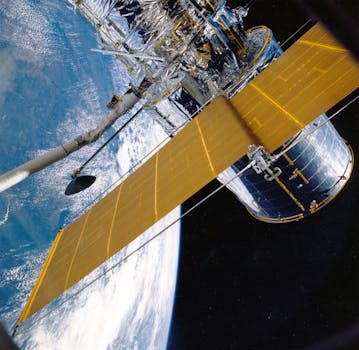
The Future of Satellites: Revolutionizing Global Connectivity
The future of satellites is rapidly evolving, with advancements in space technology and increasing demand for global connectivity. Satellites have been a crucial part of modern communication systems, providing internet access, navigation, and weather forecasting services to billions of people around the world. As the world becomes increasingly dependent on satellite technology, the industry is experiencing a significant transformation, driven by innovations in spacecraft design, launch systems, and ground infrastructure.
Advancements in Space Technology

One of the key drivers of the satellite industry’s transformation is the rapid advancement of space technology. Recent breakthroughs in materials science, propulsion systems, and electronic components have enabled the development of smaller, more efficient, and cost-effective satellites. For instance, the use of 3D printing and advanced composites has reduced the weight and increased the performance of satellite components, making them more suitable for a wider range of applications.
Another significant trend in the satellite industry is the rise of reusable launch systems. Companies like SpaceX and Blue Origin are leading the charge, with their reusable rockets capable of launching satellites into orbit and returning to Earth for refurbishment and reuse. This innovation has significantly reduced the cost of access to space, making it more affordable for companies and governments to launch satellites and explore the cosmos.
Increasing Demand for Global Connectivity

The demand for global connectivity is driving the growth of the satellite industry, with an estimated 50 billion devices expected to be connected to the internet by 2025. Satellites will play a critical role in providing internet access to remote and underserved communities, where traditional fiber-optic infrastructure is lacking. The development of constellations of low-Earth orbit (LEO) satellites, such as those being launched by OneWeb and Amazon’s Kuiper Systems, will provide high-speed, low-latency internet connectivity to even the most remote areas of the world.
Satellites are also being used to support the development of emerging technologies like the Internet of Things (IoT), autonomous vehicles, and smart cities. For example, satellite-based IoT platforms are being used to monitor and manage assets in industries like agriculture, logistics, and energy, while satellite-based navigation systems are being used to support the development of autonomous vehicles.
Challenges and Opportunities

Despite the many opportunities presented by the satellite industry, there are also significant challenges to be addressed. One of the major concerns is the growing problem of space debris, which poses a significant risk to operational satellites and the environment. The development of sustainable and responsible practices for the launch, operation, and disposal of satellites is critical to ensuring the long-term health of the space environment.
Another challenge facing the satellite industry is the need for regulatory frameworks that can keep pace with the rapid evolution of the technology. Governments and regulatory bodies must work together to establish clear guidelines and standards for the development and operation of satellites, while also ensuring that the benefits of satellite technology are accessible to all.
Conclusion

In conclusion, the future of satellites is bright, with advancements in space technology and increasing demand for global connectivity driving the growth of the industry. As the world becomes increasingly dependent on satellite technology, it is critical that we address the challenges and opportunities presented by this rapidly evolving field. By working together to develop sustainable and responsible practices, establish clear regulatory frameworks, and invest in the development of new technologies, we can ensure that the benefits of satellite technology are accessible to all and that the industry continues to thrive for generations to come.
See more:





